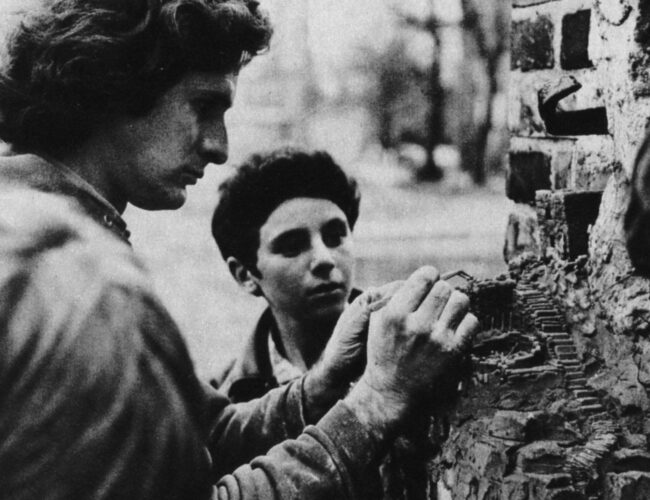The Tiny House Movement
BY PENELOPE HUNTER-STIEBEL
Nowhere can the unique beauty of the Santa Fe style be better appreciated than in the courtyard of the New Mexico Museum of Art, where you can take in its sculpted silhouette against the intensely blue sky. But few have discovered the hidden treasure tucked away in a blind window in the southwest corner of the portal.
It appears at first to be a repository of windblown debris on a model of a Southwest archaeological site. But look closely at the carefully created tumbled towers and the subsequently cracking rockwork that may at any minute dislodge itself from the sheltering cliff. Here the ephemeral present meets a past that exists exclusively in the mind of the internationally renowned artist Charles Simonds (born 1945). I fell under his spell years ago when I discovered a “Dwelling” created by his fictive Little People lodged above a window on the stairs of the former Whitney Museum in New York, and its two companion pieces sited on the ledge and rooftop of a building directly across the street. So powerful was the mythology that Simonds created, evoking a fantasy microcosm of a civilization like those uncovered in ruins of the Southwest, that my instinctive thought on coming upon a Dwelling in Santa Fe was relief that the Little People had found their way home.
In the 1970s, ephemeral clay landscapes, their miniature structures built with tiny bricks and assembled with tweezers, could be found in unlikely crannies on the streets of lower Manhattan as the young Simonds escaped the confines of the art market to engage and enchant the residents of what were then bleak neighborhoods. He went abroad to create street 1970 and 1974, emerging from the earth and constructing dwellings directly on his clay-covered body. Their forms were influenced by his memory of a childhood trip to New Mexico when his mother was visiting the School for the Deaf. She took him to pueblos and ruins around the state, where he returned regularly as a young adult.
It would seem natural that the New Mexico Museum of Art would make acquisitions of his work, and Lucy Lippard was instrumental in bringing this work to the museum. Simonds had introduced her to the Southwest in December 1972, when they visited pueblos and camped at Chaco Canyon. In 1995 she gave up her art-filled loft in Soho for a small adobe in Galisteo and allowed Bard College to tour a selection of the works she owned called Sniper’s Nest: Art That Has Lived with Lucy Lippard. Its final venue was the New Mexico Museum of Art, where she added still more works, donating most at the conclusion of the show to form a foundation for the museum’s representation of minimalist, conceptual, political, and feminist artists, including work by Simonds.
On the occasion of that exhibition, Simonds agreed to create the piece in the museum courtyard. Like all the works in her collection, this one had personal meaning to Lippard: she had lived with the artist for eight years and remains a close friend. She recalled that the Dwelling was, in her terms, “a payback” for one that he had intended to construct on her New York windowsill as a Christmas present. Instead, he only did a clay slab with the raised text, “A Home for Wayward Little People on Your Window Ledge.”
The Metropolitan Museum of Art has taken over the former Whitney building, now dubbed the Met Breuer, and an Apple store now occupies the building opposite. So I was vastly relieved to find that the Dwellings are restored and in place. No trace may remain of the Little People’s earlier passage through the New York’s gentrified Lower East Side, but there is one other place where Simonds’s magic remains hidden in plain sight— the quiet courtyard of the New Mexico Museum of Art.
Penelope Hunter-Stiebel was a curator at the Metropolitan Museum of Art and the Portland Art Museum, Oregon, before settling in Santa Fe







